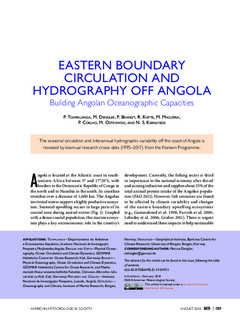| dc.description.abstract | The eastern boundary region off Angola encompasses a highly productive ecosystem important for the food security of the coastal population. The fish-stock distribution, however, undergoes large variability on intraseasonal, interannual, and longer time scales. These fluctuations are partly associated with large-scale warm anomalies that are often forced remotely from the equatorial Atlantic and propagate southward, reaching the Benguela upwelling off Namibia. Such warm events, named Benguela Niños, occurred in 1995 and in 2011. Here we present results from an underexplored extensive in situ dataset that was analyzed in the framework of a capacity-strengthening effort. The dataset was acquired within the Nansen Programme executed by the Food and Agriculture Organization of the United Nations and funded by the Norwegian government. It consists of hydrographic and velocity data from the Angolan continental margin acquired biannually during the main downwelling and upwelling seasons over more than 20 years. The mean seasonal changes of the Angola Current from 6° to 17°S are presented. During austral summer the southward Angola Current is concentrated in the upper 150 m. It strengthens from north to south, reaching a velocity maximum just north of the Angola Benguela Front. During austral winter the Angola Current is weaker, but deeper reaching. While the southward strengthening of the Angola Current can be related to the wind forcing, its seasonal variability is most likely explained by coastally trapped waves. On interannual time scales, the hydrographic data reveal remarkable variability in subsurface upper-ocean heat content. In particular, the 2011 Benguela Niño was preceded by a strong subsurface warming of about 2 years’ duration. | nb_NO |
